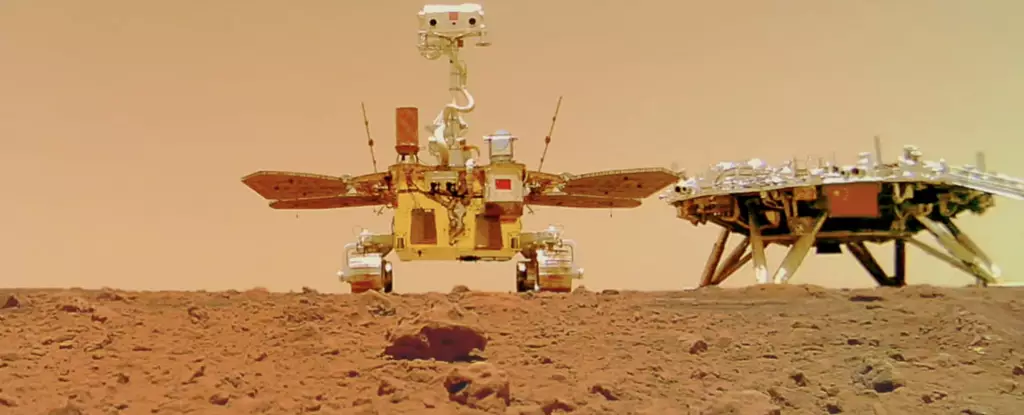The exploration of Mars has always been a fascinating subject for scientists and space enthusiasts worldwide. Recently, China’s Zhurong rover made remarkable discoveries on Mars, shedding light on the mysterious features hidden beneath the planet’s surface. Equipped with a ground-penetrating radar system, Zhurong conducted scans of its landing site in Utopia Planitia, revealing the presence of irregular polygonal wedges. These enigmatic formations, measuring from centimeters to tens of meters across, were found at a depth of approximately 35 meters along the rover’s path. While researchers believe that freeze-thaw cycles billions of years ago contributed to their creation, volcanic activity from cooling lava flows remains another possible explanation.
On May 15, 2021, history was made as China successfully landed its Zhurong rover on Mars, becoming the second country to achieve this feat. Named after a Chinese god of fire, Zhurong embarked on a mission to explore the red planet’s surface. During its one-year operation, the rover sent back captivating images, including a remarkable selfie with its lander, captured by a remote camera. Furthermore, Zhurong meticulously studied Mars’ topography and employed its ground-penetrating radar (GPR) instrument for measurements.
Researchers from the Institute of Geology and Geophysics under the Chinese Academy of Sciences collaboratively worked with Zhurong’s data and highlighted the significance of the GPR in complementing orbital radar explorations. While missions such as ESA’s Mars Express and China’s Tianwen-1 orbiter have provided essential insights, the in-situ GPR survey conducted by Zhurong offers critical local details of shallow structures and composition within approximately 100-meter depths along the rover’s traverse. This valuable data provides a comprehensive understanding of Mars’s geological history.
Utopia Planitia, a vast plain within the larger Utopia impact basin, served as Zhurong’s landing site and a focal point for its investigations. During its time on Mars, the rover covered a distance of 1,921 meters, collecting crucial information along its path. In a recent publication in Nature, the researchers led by Lei Zhang revealed that Zhurong’s radar detected sixteen buried polygonal wedges within a distance of about 1.2 kilometers, indicating a widespread distribution of similar terrain beneath Utopia Planitia. These features likely formed between 3.7 and 2.9 billion years ago during the Late Hesperian-Early Amazonian epochs of Mars, potentially coinciding with the decline of an ancient wet environment. The subsequent burial of the palaeo-polygonal terrain by later geological processes suggests complex changes over time.
While polygonal terrains have been observed in various regions of Mars through previous missions, the discovery of buried polygonal features is unprecedented. According to the researchers, the formation of these buried polygons requires a cold environment. They hypothesize that water/ice freeze-thaw processes in southern Utopia Planitia on early Mars may be responsible for the creation of the wedges. The source of this water and ice could be cryogenic suction-induced moisture migration from an underground aquifer, snowfall from the air, or vapor diffusion for pore ice deposition. Additionally, earlier radar data from Zhurong suggested the existence of multiple floods during the same time frame, creating distinct layers beneath the surface of Utopia Planitia. The researchers propose that soil contraction from wet sediments drying, leading to the formation of mud-cracks, or thermal contraction cracking from cooling lava flows may have contributed to the observed polygonal wedges. Regardless of the exact mechanisms, the presence of these formations indicates a significant climatic transformation in Mars’ history.
China’s Zhurong rover has undeniably expanded our knowledge of Mars and its geological features. The uncovering of buried polygonal wedges within Utopia Planitia provides valuable insights into the planet’s history and climate. These intriguing discoveries signify the influence of freeze-thaw cycles or volcanic activity in shaping the planet’s surface billions of years ago. With further exploration and research, we are poised to unravel more secrets hidden beneath the mysterious red planet’s surface.


Leave a Reply